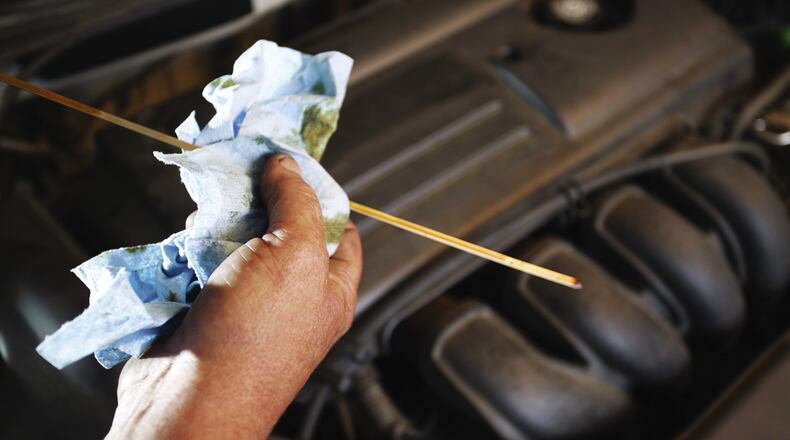Now that I’m retired, I only drive it around 3,000 miles a year. The oil change plan provides for quarterly oil changes.
Since I am only driving 3,000 miles in a year, is it OK to only change the oil once or twice a year, or does the oil degrade over time just from sitting there and not only from miles driven? -- John
RAY: You’re the reason they jacked up the price of that lifetime oil change plan to $2,500, John.
By now, they might be putting Filippo Berio Extra Virgin Olive Oil in your crankcase, hoping to kill off your F-150 and finally get rid of you.
Oil degrades from being used, John. Not from sitting around. As the oil circulates with the engine running, it gathers up contaminants and holds them in suspension.
Eventually, it gets dirty, and can’t absorb any more carbon, soot or water, and then it can’t lubricate as well. That’s when it needs to be changed.
Modern engine oils, even the cheap stuff they probably give you with your free oil changes, can easily go 5,000 miles before needing to be changed. Probably longer. Synthetic oils, which are even better, can go twice that long.
If you really neglected your oil for tens of thousands of miles, the long chain molecules that do the lubricating would eventually break down. But dirt is going to be an issue well before chemical breakdown is.
So the answer is, yes, you can get less frequent oil changes, John. You might try negotiating with the dealer. Say “Hey, look, you’re sick of seeing me every three months for my free oil and filter. How about you give me full synthetic oil, and I’ll just come in once a year.”
They’ll pay more for the full synthetic, but they’ll save three filters, an hour and a half a year of labor and the annoyance of having to be reminded that they’re making three bucks each time they change your oil.
You’ll be fully protected and give them fewer opportunities to sabotage your engine. Even if they won’t splurge for the full synthetic oil, with only 3,000 annual miles, you can still cut back your oil changes to once or twice a year with no worries, John.
‘Peanut butter’ gumming up Camry could be a sticky situation
Dear Car Talk:
My 2015 V6 Toyota Camry has a substance that the mechanics can only describe as “peanut butter” gumming up my heater core, coolant system and now the engine.
I have included a picture. So far, no one knows what this stuff is or how it got there. Any idea what it might be or why it can’t be cleaned out after 17 times of draining and flushing the system? -- Amy
RAY: Wow. If you can figure out how to get the engine to make some grape jelly, you can start a lucrative lunch business, Amy. It does look kind of like peanut butter. But, unfortunately, it’s going to cost you many, many jars of Skippy to fix.
I think oil is getting into your coolant. There are separate passages inside your cylinder head for oil and coolant. And they’re kept separate by a complex seal called the head gasket.
If that head gasket breaks -- which often happens if the car is badly overheated -- oil and coolant can then mix together. They can go either way. Coolant can get into the oil, or oil can get into the coolant, which is what’s happening in your case.
And that’s why, despite flushing it out 17 times, it keeps making peanut butter, because new oil gets into your coolant every time you drive the car.
At minimum, you need a new head gasket. You have two of them on this V6 engine, one for each bank of three cylinders. Replacing both of them is probably a $2,500 job.
But the news could be even worse. The head itself could be cracked -- which also can happen during severe overheating. In that case, you’d need an engine rebuild or a replacement engine. Which means you’d be subsisting on peanut butter for a while.
There’s a slight chance that it’s transmission fluid in your coolant, coming from the transmission cooler, which sits inside the radiator. That would be a lucky break. So check that. But I think it’s more likely to be a head gasket or head.
I wish the news was better, Amy.
My suggestion would be to have your mechanic start by removing the cylinder head closest to the front of the car. That’s the easier one to work on.
If you’re lucky, he’ll see a clearly broken head gasket between an oil passage and a coolant passage. And if you want to save money, you can just ask him to replace that head gasket, close it up and hope for the best.
Normally, we’d replace both gaskets, figuring if one has failed, the other might, too. But if funds are really tight, you can take your chances on one of them.
If there are no visible head gasket breaches in either cylinder head, then you’ve got a decision to make, Amy. You can either spring for a used or remanufactured engine or craft a used car ad that includes the words “as is.” Best of luck to you.
* * *
Got a question about cars? Write to Ray in care of King Features, 628 Virginia Drive, Orlando, FL 32803, or email by visiting the Car Talk website at www.cartalk.com.
(c) 2022 by Ray Magliozzi and Doug Berman
Distributed by King Features Syndicate, Inc.
About the Author

